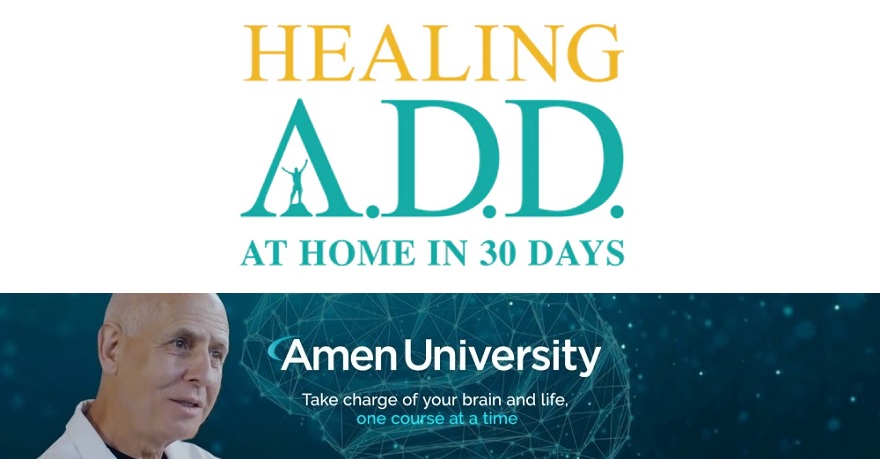
Living with attention deficit problems can feel confusing. One day you feel motivated and on track, the next day simple tasks seem impossible. Many people with ADD or ADHD are told only part of the story, that they are lazy, careless, or not trying hard enough. Dr Daniel Amen’s Healing ADD at Home In 30 Days course is built around a different idea, that attention problems are strongly linked to how the brain is working and that daily choices can either help or hurt that brain.
The course brings together brain imaging insights, practical psychology, and everyday routines in a format that people can use from home. It is not a replacement for medical care, but it gives individuals and families a clearer picture of how ADD shows up in real life, why it looks different from person to person, and which daily habits tend to ease or intensify symptoms.
Contents
- What The Healing ADD at Home Course Is Designed To Do
- How The Course Is Structured
- Key Ideas About ADD Highlighted In The Course
- Daily Tools The Course Teaches For Managing Symptoms
- How The Course Approaches Medication And Professional Care
- Who The Healing ADD at Home Course Helps Most
- Putting The Lessons Into Everyday Life
What The Healing ADD at Home Course Is Designed To Do
Healing ADD at Home is meant to do two main things. First, it helps people understand that ADD is more than distractibility, it is a pattern of brain functioning that affects planning, follow through, emotions, and even motivation. Second, it teaches specific lifestyle and thought tools that can support the brain so that symptoms become easier to manage in real time.
A Brain Based View Of ADD
Instead of describing ADD only as a behavioral problem, the course talks about it as a brain health condition. Dr Amen draws on SPECT imaging findings from his clinics to show how different patterns of activity in the brain may relate to focus, impulsivity, or low motivation. The goal is not to diagnose from imaging at home, but to help people see that ADD is tied to real brain differences and that changing brain health often changes symptoms.
Normalizing The Experience Of ADD
Another purpose of the course is to reduce shame. Many people with ADD have a long history of criticism from school, work, and even family. Healing ADD at Home repeatedly emphasizes that attention problems are not moral failures. When people see their challenges through a brain lens, they are more willing to try structured strategies instead of giving up or hiding their struggles.
How The Course Is Structured
The program is delivered through on demand video lessons, handouts, and simple exercises. Lessons are divided into short segments that focus on topics such as types of ADD, brain systems, lifestyle risk factors, and daily management tools. This structure works well for people whose attention tends to wander because they can watch in smaller chunks and return to sections that feel especially relevant.
Quizzes and worksheets help participants apply what they learn to their own lives. The course is flexible enough to be used by adults with ADD, parents of children or teens, couples, and even helping professionals who want to understand Amen style concepts more deeply.
Key Ideas About ADD Highlighted In The Course
Several core ideas are woven through the entire training. Together they form a framework for understanding ADD beyond simple labels.
ADD Comes In Different Patterns
Healing ADD at Home describes multiple patterns of ADD instead of one single type. These patterns are based on common symptom clusters and brain activity themes. Some people are primarily inattentive, some are overfocused and rigid, some are restless and impulsive, and others struggle with mood swings alongside attention problems. Recognizing that there are different patterns helps people understand why one person with ADD may look very different from another.
Lifestyle Choices Affect Brain Symptoms
The course emphasizes that sleep, diet, exercise, stress load, toxins, and digital habits all affect how ADD symptoms appear. Poor sleep and heavy screen time can make distractibility worse. Physical activity, structure, and nourishing food tend to help the brain regulate attention more effectively. This does not mean lifestyle is the only factor, but it is presented as a powerful piece of the puzzle.
Relationships And Environments Matter
ADD does not exist in a vacuum. Family dynamics, school expectations, workplace demands, and relationship stress can either support or strain the brain. Healing ADD at Home encourages parents, partners, and teachers to see how their expectations and systems affect someone with attention challenges and to adjust those systems where possible.
Daily Tools The Course Teaches For Managing Symptoms
One of the most useful parts of the training is its focus on practical tools that can be used right away. The course places these tools in the context of brain health so they feel purposeful rather than random.
Structuring The Day Around The Brain
Participants learn how predictable routines support attention. The course suggests using consistent wake and sleep times, planning high focus tasks during the part of the day when energy is best, and breaking large tasks into shorter blocks with clear start and stop points. Visual schedules, alarms, and checklists are encouraged so the brain has less to remember and more space to focus.
Using Body Based Strategies To Support Focus
Movement, posture, and physical environment have strong effects on attention. Healing ADD at Home teaches strategies such as movement breaks, standing or active workstations when possible, fidget tools that do not distract others, and sensory adjustments like reducing noise or clutter. These changes help the brain stay alert without relying only on sheer willpower.
Addressing Automatic Negative Thoughts
The course also covers how thinking patterns influence behavior. Many people with ADD carry quiet messages such as I always fail, I am just lazy, or there is no point in trying. Dr Amen walks through ways to catch these automatic negative thoughts, question their truth, and replace them with more accurate and hopeful statements. This mental skill helps people stay engaged with their plans instead of giving up at the first setback.
Building Brain Healthy Habits
Healing ADD at Home reinforces basic brain health habits, including consistent sleep routines, protein rich meals, limiting excess sugar and caffeine, regular exercise, hydration, and mindful technology use. The course shows how small improvements in these areas often reduce ADD symptoms enough that other therapies and strategies work better.
How The Course Approaches Medication And Professional Care
Medication is not ignored in the program, but it is placed in context. The teaching is clear that medication decisions belong with licensed medical professionals and should be tailored to each person. Healing ADD at Home does not promise that lifestyle alone will solve all attention problems, and it does not encourage anyone to change prescriptions without supervision.
Encouraging Collaborative Care
The course encourages participants to share what they learn with their clinicians. By understanding their own sleep, stress, habits, and thought patterns, people can give clearer histories and ask more specific questions during appointments. This collaboration tends to produce more effective and personalized treatment plans.
Who The Healing ADD at Home Course Helps Most
The program is especially helpful for adults who suspect they have ADD or are already diagnosed but feel they lack a daily management plan. Parents of children and teens often use the course to better understand their child’s behavior, create more supportive home routines, and communicate with schools in a more informed way.
Partners and family members also benefit. When they see how ADD affects motivation, time awareness, and emotion regulation, they often shift from constant frustration toward more practical problem solving and empathy.
Putting The Lessons Into Everyday Life
The real value of Healing ADD at Home comes from how people use it outside the videos. The course encourages participants to choose a few strategies at a time rather than trying to change everything overnight. That might mean starting with better sleep, a structured morning routine, and a simple system for tracking tasks. As those habits take root, more tools can be added.
Over time, many people notice fewer crises, less last minute scrambling, and more consistent follow through. Symptoms do not vanish, but they become easier to work with. By viewing ADD through a brain based lens and using daily tools to support that brain, the course shows that meaningful progress is possible in real homes and busy lives, not just in clinic settings.

